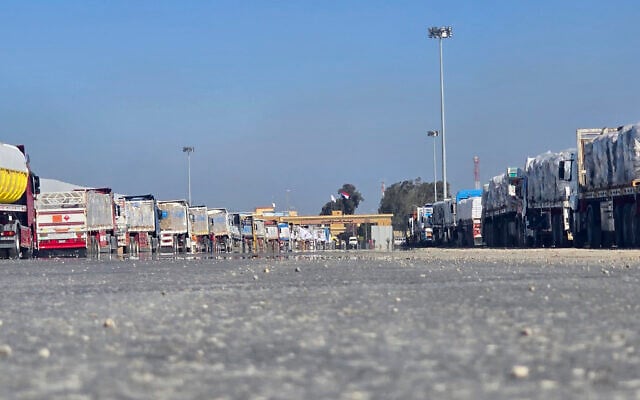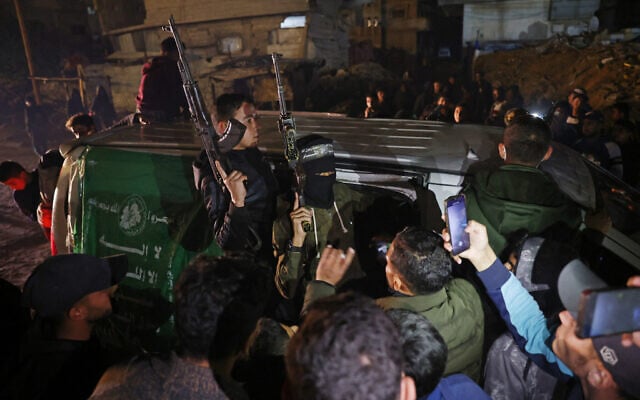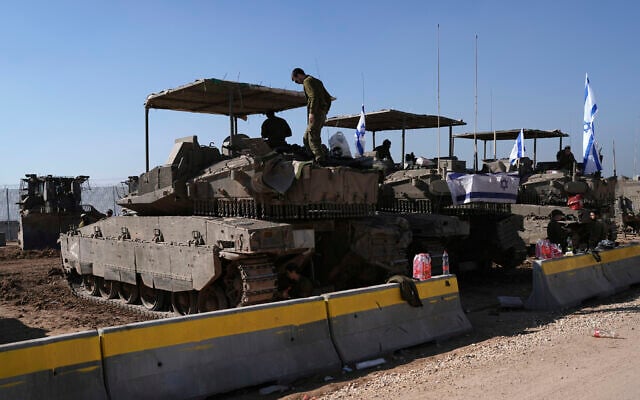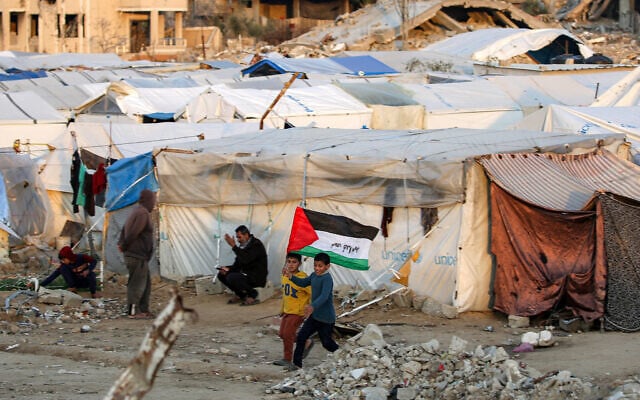



The ceasefire between Israel and the Hamas terror group in the Gaza Strip will come into effect on Sunday at 8:30 a.m. local time, Qatar and the Israel Defense Forces said Saturday. Hours later, the first Israeli hostages and Palestinian prisoners will be released under the agreement.
“As coordinated by the parties to the agreement and the mediators, the ceasefire in the Gaza Strip will begin at 8:30 a.m. on Sunday, January 19, local time in Gaza,” Qatar’s Foreign Ministry spokesman Majed al-Ansari said on X. “We advise the inhabitants to take precaution, exercise the utmost caution, and wait for directions from official sources.”
The IDF in a statement also confirmed the ceasefire’s start time.
Israeli officials said Saturday that they were expecting to receive the names of the first three hostages to be released on Sunday by the evening, adding that Hamas will give the names to the Qataris, who will then inform Mossad Chief David Barnea, who is then expected to inform the families.
The first three hostages to be released on Sunday will be civilian women on the list of 33 hostages to be freed in the 42-day first phase of the Israel-Hamas deal, according to Israeli officials.
The Palestinian prisoners to be freed in exchange for the three hostages will not be released before 4 p.m. on Sunday — roughly when the first hostages are expected back in Israel, some 7.5 hours after the ceasefire comes into effect.
In exchange for all 33 hostages, Israel will, by the end of phase one, hand over up to 1,904 Palestinian prisoners and detainees, including several serving multiple life sentences for deadly terror attacks and murders.
As part of the first phase of the deal, a major surge of humanitarian aid will also flow into Gaza, with Egypt saying that 50 fuel trucks are set to enter the Strip when the ceasefire starts on Sunday morning.
Egyptian Foreign Minister Badr Abdelatty, whose country mediated the deal with Qatar and the United States, said the agreement calls for “the entry of 600 trucks per day to the Strip, including 50 trucks of fuel.”

Hundreds of trucks have lined up on the Egyptian side of the Rafah Border Crossing — previously a vital entry point for aid that has been closed by Egypt since last May, when Israeli forces seized the Palestinian side.
At a joint news conference on Saturday with his Nigerian counterpart, Abdelatty said: “We hope that 300 trucks will go to the north of the Gaza Strip,” where thousands are trapped in what aid agencies say are desperate conditions.
According to a report by the BBC, citing a senior Palestinian official, as part of the security arrangements between Israel and Hamas in the upcoming ceasefire, Israel will allow Hamas policemen who deal with the civilian population to operate in their blue uniforms in certain Gaza areas.

The report said Hamas policemen will oversee the movement of displaced people within Gaza but will avoid areas where IDF troops remain located in the Strip. They will carry weapons when they must, and Egyptian and Qatari officials will help mediate in the event of any conflicts between the sides.
The IDF said on Saturday that it had begun preparations for the ceasefire, and was readying to receive hostages and “implement the operational procedures” that the agreement dictates, likely referring to the withdrawal of IDF troops from populated areas within Gaza to certain agreed-upon zones.
“The IDF has been preparing to receive the hostages upon their release from Hamas captivity and is acting to provide suitable physical and psychological support, with careful attention to every detail,” the statement continued.
“Alongside the agreement and our commitment to bringing home all the hostages, the IDF will continue to operate in order to ensure the security of all Israeli citizens, particularly those in communities near the Gaza Strip,” it added.

As part of the preparations, the IDF established three complexes near the border with Gaza to receive the released hostages, where they will meet with IDF representatives, including doctors, psychologists and mental health officers.
The complexes have been erected at Re’im Base, the Kerem Shalom Crossing and the Erez Crossing. Hostages released from Gaza will reach one of the three sites depending on their release route.
The military’s 99th Division will withdraw from the Netzarim Corridor of central Gaza, the 162nd Division will be tasked with defending the northern Gaza area, and the Gaza Division will be responsible for the southern portion of the Strip. The Gaza Division will also withdraw gradually from parts of the Philadelphi Corridor area under the deal.
Under the first stage of the agreement, the IDF said Palestinian civilians will not be allowed to return to areas where the military has a presence, as well as areas close to the border.
“The IDF is prepared with clear lines of defense and is ready to remove threats. Any threat to our forces will receive an aggressive response,” the military said.

The ceasefire agreement, which was approved by Israel’s government on Friday night, will bring a halt to the 15-month-long war between Israel and the Palestinian terror group Hamas, which began when Hamas-led terrorists invaded southern Israel, killing over 1,200 people and kidnapping 251 hostages during their October 7, 2023, onslaught.
It is believed that 94 of the hostages abducted during the Hamas onslaught remain in Gaza, including the bodies of at least 34 confirmed dead by the IDF.
Hamas released 105 civilians during a weeklong truce in late November, and four hostages were released before that. Eight hostages have been rescued by troops alive, and the bodies of 40 hostages have also been recovered, including three mistakenly killed by the military as they tried to escape their captors.
Hamas is also holding two Israeli civilians who entered the Strip in 2014 and 2015, as well as the bodies of two IDF soldiers who were killed in 2014.
